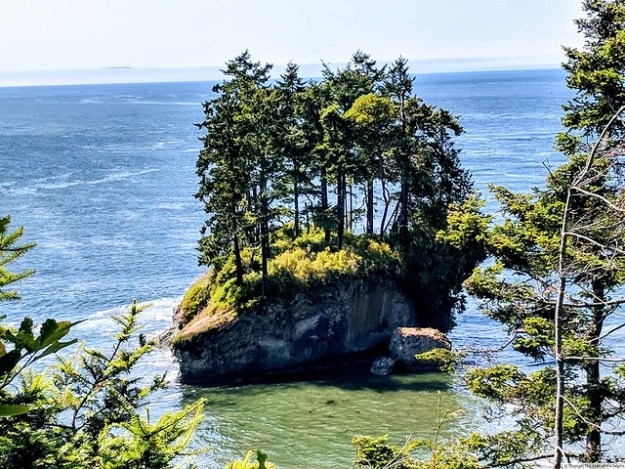Leaving Utah, we headed northwest into Idaho. We had reservations for a week at a campground about ten miles south of Twin Falls.
Twin Falls city, pop 45,000 is a lovely city with waterfalls, big and small in all directions. Twin Falls is the center of 500,000 acres of prime farmland irrigated by the waters of the Snake River. This area is referred to as “Magic Valley” because the early settlers seemed to magically transform the arid, largely uninhabitable land into a lush, agricultural paradise by irrigating their fields with water from the nearby Snake River. 
Twin Falls is also on the edge of the Snake River Canyon which was gouged out by the Great Bonneville Flood 15,000 years ago.
The city got its name from the two falls co-located on the Snake River that resulted from this flood. However the 1935 Twin Falls Dam and power plant, built to control the flow of water for irrigation and hydroelectric power, diverted the flow of the Snake River away from the southern falls. This left a single waterfall that plunges 200 feet into the Snake River from upstream lakes. So Twin Falls is no longer a twin falls. The power plant is capable of generating enough power to provide electricity for approximately 31,900 homes. 


Five miles northeast of Twin Falls city is the much more impressive Shoshone Falls where the rushing white waters of the Snake River plunge more than 212 feet. It is called “the Niagara of the West” which is quite a stretch in our opinion. It is said to be one of the tallest waterfalls in the United States and is 46 feet higher than Niagara Falls. 


We stopped by the Visitors Center at the Perrine Bridge. 
The bridge, called the “Gateway to Twin Falls”, spans 1,500 feet and rises 486 feet above the Snake River Canyon. It is a popular bridge for parachute jumping. 



In a nearby park is the Perrine Coulee Falls, which free falls nearly 200 FT. 
In 1974 Evel Knievel attempted to fly his sky cycle/rocket across the Snake River Canyon but was not successful because his parachute opened too soon. There was a memorial to Knievel for many years but the plaque was continually stolen so the memorial is no longer available.
Another day we drove the 68 mile Thousand Springs Scenic Byway through farmland with natural springs, hot mineral springs and cascading waterfalls. 





We drove through Buhl, the “Trout Capital of the World” which produce a majority of the rainbow trout consumed in the United States.

Parts of the Byway had visible evidence of volcanic rock known in this part of Idaho. The area is known as “A Land Born of Fire and Water”. 

We really enjoyed our visit to beautiful Twin Falls/Magic Valley. During the week the weather ranged from a high of 94 degrees one day followed by days with highs in the upper 40’s to low 50’s with strong winds. 
Next up: Pocatello, Idaho as we work our way toward Yellowstone.

































































































































































































































































